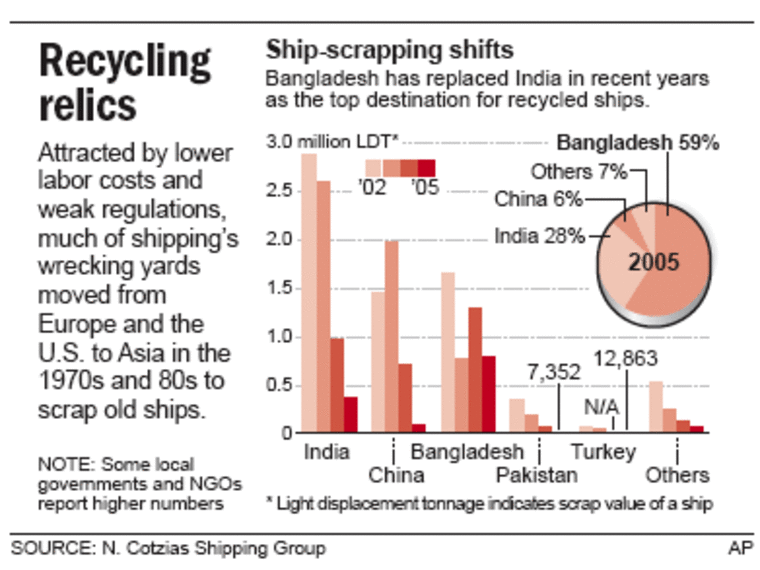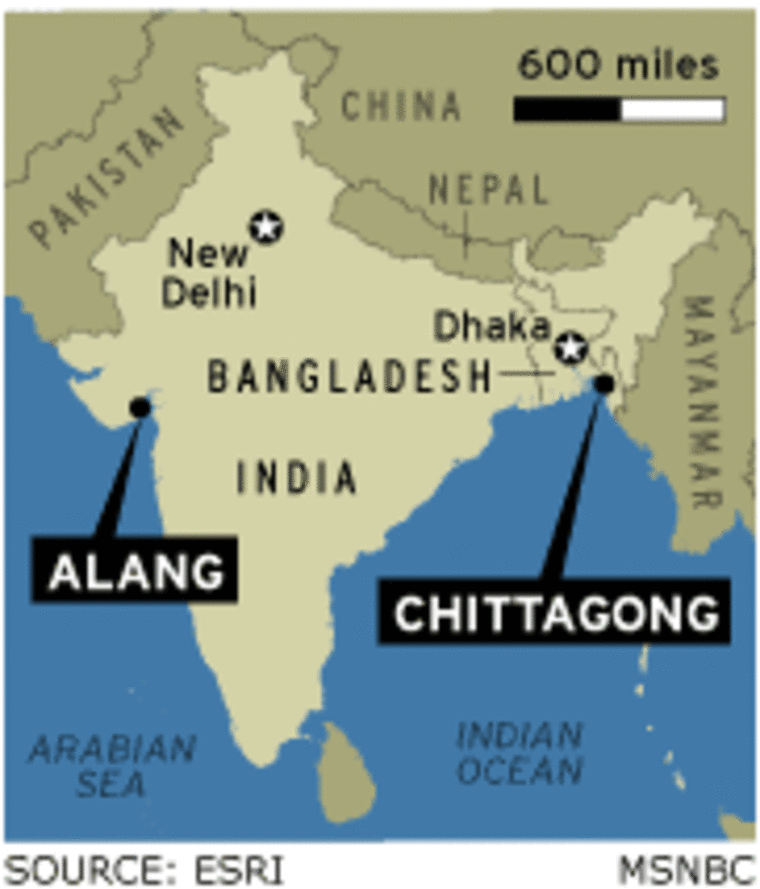When the big ships come to Asia to die, they often take lives with them. Upendra Shethi knows.
He was one of an army of laborers hired by an Indian ship-breaking yard to strip the 50-year-old China Sea Discovery for scrap four months ago. The ship suddenly caught fire, burning at least five men alive and injuring 15 more.
“In a matter of five minutes, the entire ship was in flames and there was complete chaos in the yard,” the 29-year-old Indian recalls.
The conditions that so quickly turned the Chinese- and Canadian-owned luxury liner into a deathtrap have long been familiar along India’s grimy west coast beaches. Now they are stirring a worldwide controversy that has stung the Indian government into taking action and led to the drafting of an international agreement to police the industry.
But Greenpeace and other advocacy groups say the remedies aren’t enough.
Playing out in places such as this seaside town of Alang is a little known drama of modern consumer life.
The ships that come here on their final voyage have spent decades carrying holidaymakers on cruises or delivering the cars and bicycles, microwave ovens and DVD players, sneakers and sweat shirts, coal and oil — all the ingredients of daily life.
Now, rusty and barnacled, they are rammed ashore and quickly cannibalized for every speck of recyclable material.
These older ships, some as tall as 15-story buildings and as long as several football fields, are not broken up in the West because they are full of dangerous materials such as asbestos that would not pass health standards.
So Asia has become a cheap alternative. India used to lead the industry, but breakers there say their business is diminishing sharply and neighboring Bangladesh has taken its place.
Recent controversies
International awareness of the problem has been heightened lately. In February the French aircraft carrier Clemenceau, bound for breakup in Alang, was forced to return to France because it contains up to 1,000 tons of asbestos.
The storied passenger liner SS France, now rechristened the Blue Lady, spent weeks on a ghostlike voyage in the Indian Ocean, unable to get into any of the breakers’ yards that were supposed to strip it. Even Bangladesh turned it away. An Indian court finally allowed it to sail to Alang and it is due to arrive there in the coming days.
Ship-breaking is done by uneducated migrants with little safety equipment who earn a dollar or two a day — but still twice as much as they could make at home.
The Gujarat Maritime Board, which oversees the Alang shipyard, has told Greenpeace that 372 workers have died at Alang since the ship-breaking industry came here in 1982. Bangladesh has suffered 180 deaths and 700 injured in the past 11 years, police say.
But Greenpeace and the International Federation of Human Rights claim, based on worker interviews, that the number is much higher — 50 to 60 a year in each country.
“It’s like hell on earth,” said Paul Bailey, a ship-scrapping expert with the U.N.’s International Labor Organization. “Working conditions are dangerous. You’re dismantling the ship and taking it apart. It’s a moving target and things are changing all the time.”
The West has dry docks and heavy equipment, but these are expensive. In Asia’s yards regulation is weak and the work is done mostly by hand.

Hundreds scrapped yearly
A fourfold increase in world steel prices, to hundreds of dollars a ton, has boosted the industry. Hundreds of ships are scrapped annually, and thousands of single-hulled tankers are being retired in the coming years.
The heightened environmental pressure and negative publicity, though, has made the industry secretive and defensive. The Gujarat Maritime Board refused The Associated Press’ repeated requests to visit a yard.
However, in interviews, workers gave vivid descriptions of the work.

The ships are run ashore at high tide and laborers clamber up the anchor chains to strip it of everything from furniture to engines, using blowtorches and bare hands.
Amid the clanging of hammers and the smell of burning metal, workers let huge chunks of steel plunge several stories to the ground. Dozens of men drag slabs of steel weighing hundreds of pounds to trucks. Within a few months the ship is piles of scrap.
Conditions are worse in Bangladesh, activists say. There, women recycle asbestos by hand, barefoot workers stand knee-deep in oil, medical facilities are almost nonexistent and children are often used as laborers, they say.
Off Alang in India and Chittagong in Bangladesh, ships sit in various states of disrepair — the deck of a listing ferry ripped open, a cargo ship stripped to its hull.
Workers live in crowded shacks with no running water or electricity and say accidents are part of their job.
“I’ve seen people lose their hands. I’ve seen people die,” said Trinath Jena, who has worked in the yards for two decades and saw a friend killed in 1996. “Every day there are accidents both big and small.”
Workers say the owners often try to cover up accidents, offer little compensation to the injured and pay only for the funerals of the dead.
One worker showed scars on his back and legs from a gas explosion in Alang in which he was severely burned and permanently disabled. The family of another said he was killed by a falling oxygen canister. Another lost his leg, crushed by a steel plate.
Belal, a 28-year-old Bangladeshi ship-breaker who gave only his first name for fear of retribution from his employer, said he has worked in the yards since he was 13. With few jobs in his home district of Jamalpur in the north and a family of seven to support, Belal said his family might starve but for the $1.10 a day he earns breaking up ships.
Belal said he prays before going to work “because I don’t know whether I will go back to my lodging safely at the end of the day.”
Lung illnesses
Doctors in Alang say they see as many as 100 cases a week from the shipyards, many of whom have lung damage from toxic fumes and often end up back in their villages, too sick to work and too poor to afford medical care.
Indian ship-breakers say activists exaggerate the dangers, and claim accidents have dropped significantly. But so has their business.
They say their competitors in Bangladesh offer higher prices for vessels and don’t have to deal with tough regulations.
That means far fewer ships are coming to Alang. An industry that supported 40,000 workers five years ago in Alang now only employs 3,500, the ship-breakers said, and all but 26 of the 173 Indian ship-breaking sites sit idle.
“Nowadays, we are getting too much harassment from the NGOs and the government,” said Haresh Parmar of Shiv Ship Breaking Co. “We are doing nothing wrong. We are running a healthy recycling industry that provides many jobs.”
India’s yards are following the example set by Turkey and China in recent years. A hospital has been built for workers, winches and cranes have been introduced and workers now wear hard hats, boots and gloves. Ship inspections are on the rise and boats have to be empty of the fuel that is blamed for most fires — although activists say corruption sometimes allows ship-breakers to bypass these regulations.
Work on maritime pact
The safety push comes as the International Maritime Organization is drafting an agreement to be signed possibly in 2008 that would require ships to provide lists of all hazardous materials onboard and recycling yards to meet a set of safety standards.
Countries that sign the pact would be barred from sending their ships to be scrapped in unlicensed yards, according to a draft seen by The AP.
Greenpeace says the guidelines should require ships to be decontaminated in their home ports. The industry says that would be costly and impractical.
But the human price of ship-breaking is evident in Adapada, a village of 5,000 along the country’s east coast that for two decades has exported many of its men to the Alang yards 620 miles away.
At least two dozen residents of this isolated farming village have died in the shipyards, according to village leaders and surviving relatives, while others have lost arms or legs.
Dilip Pradham, 60, suffers debilitating headaches and, until recently, was bedridden following a 1996 gas explosion in Alang. He no longer works and is forced to beg.
His daughter, Phula, says he was the breadwinner, and without his income the family often goes hungry and can’t afford a dowry for one of its marriage-age daughters.
“We’ve lost our father,” Phula said.
